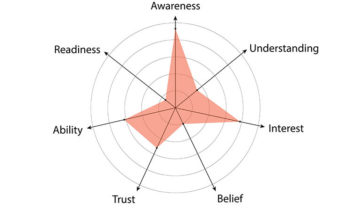Making Friends: The ABCs of an Introductory Call
Cavin Segil has an easy laugh and long, unmanageable hair. It wasn’t always so. He used to have short hair, but he heard about a program that donates wigs to cancer victims made of real hair and decided he wanted to help out. Commendable to be sure, but the problem for all of us who count him as our friend is that the long hair looks good. We will miss his curly mane when it grows out and starts its second life on someone else’s head.
I mention this because Cavin has great heart for others and that includes those whom he would like to help with his expertise. It shines through when he gets on a call with someone whom doesn’t know him but is interested in what our company does. Cavin has a good manner with them that is one part active listener, one part coach and knowledgeable guide. He knows that intent matters. A phrase can be spoken with happy, generous intent or it can come from a cloying, manipulative place. The difference is not in the words, but in the heart that Cavin brings to the call.
I sat down with him and asked him to narrate a typical introductory call with a potential client. He says they always include a handful of key components. Call them the ABCs of an introductory call:
A. Learn who they are
B. Share what you do with an example
C. Schedule a follow-up call
Understanding the Client
He starts by laying out the agenda.
“I’d like to hear a little bit about your role and the work your team is doing. Then I thought I might share some of the work we have done with other consulting and professional services firms. Finally, I thought we might just open it up to questions and have a conversation.”
This initial agenda-setting does a few things:
- It establishes you as the driver of the call. As a consequence, it relieves the potential client of that responsibility.
- It lets you obtain permission to ask them questions. We all know we shouldn’t be doing all of the talking, but sometimes it is hard to get a would-be client to open up. They’ll say something like, “Why don’t just tell me what you do.” By suggesting it makes sense that you both share and asking them to agree, “It makes it easy to then segue into a handful of questions about their objectives and challenges.”
- It lowers the temperature of the call. You are letting the client know that this is about information gathering and that they will not be pressured into making a decision.
Once they agree, you can open things by asking an initial question. Cavin suggests asking about their role in the organization. In his experience, this question is less threatening than, “Tell me your goals.” When a person starts to talk about their place in the organization, they inevitably will tell you about their practice area and the place they are trying to head.
Too often when introducing our consulting or professional services offerings we forget that clients have alternatives, including, importantly, not doing anything.
Cavin then asks follow-up questions, including, “What activities are you doing right now to get where you want to go?” Too often when introducing our consulting or professional services offerings we forget that clients have alternatives, including, importantly, not doing anything. Cavin feels it is important to understand and respect efforts underway before talking about how he could complement existing work. He knows that ignoring projects that are already underway is a sure path to creating institutional detractors inside the organization. They may generally support what you’re doing, but if they perceive your services as being in competition for time and resources, you will be surprised by how creative they can be behind closed doors with reasons why what you are proposing is a terrible idea. Be their ally — their wingman — not their competition.
Sharing What You Do
Only after he has gotten a good sense of a client’s domain and where they would like it to go does Cavin begin to talk about PIE. This allows him to use an example which is relevant to the client and allows him to show, not just say, that he has been listening. The example is more important than the abstract description of what you do. In PIE’s case, we say, “We help connect experts with those they most want to serve,” but that is an abstraction. People have a hard time hearing those words. They have to climb up from the particulars of their situation to the remoteness of your words before lowering themselves back down to how you might help them. Easier is to relate to the story of how you helped others. “We were contacted by a practice head who was charged with building his book of business in the cybersecurity space. The problem was that he didn’t know any of the decision makers in the companies they thought they could help. Here is what we did for him….” Human beings are much more adept at seeing how parallel experiences relate to their situation than they are at inferring value from the world of big words.
Answering Questions
Quickly, though, he tries to stop talking. Hearing them out and sharing what he does shouldn’t take more than fifteen minutes, leaving plenty of time for questions and discussion.
“How is that possible,” you ask? How can you be expected to make your pitch in only five minutes? The answer is you only need to get the headline of what you are offering out on the table and give an example of what you do. The temptation is to try and say too much. You have been on dozens of these calls before and know what the objections will be. Why not get the words out before the objections come? Let it go. Questions from a would-be client are not bad — they are not some admission that you failed to adequately present — they are the beginning of a conversation. People’s brains work better when they are engaged. If they are asking questions, it means their synapses are firing, making connections and they are thinking of possibilities. This is what you want.
Setting Follow Up
After you have had some back and forth, your time will start to draw to a close. Be aware of their time. Do not assume you are the only call on their calendar. Five minutes before your call is supposed to end, say, “I want to be mindful of your time. I am wondering if it makes sense for us to send you a short deck explaining our capabilities?” Your would-be client will always say yes. You have put yourself out on the call and they feel like they owe you something. Reciprocity demands they give you something in return. If you ask to send them some materials, they will agree because it is a low consequence way of fulfilling this obligation.
Next say, “Sounds good. Why don’t we set some time in two weeks to follow up? If you have your calendar handy, maybe we could set some time right now?”
It is highly unlikely — like the odds of an asteroid wiping you out on the way home — that you will sell a services contract in one thirty-minute call.
As Cavin says, your goal is the next call. The key here is to take the pressure to “sell something” off of yourself. It is highly unlikely — like the odds of an asteroid wiping you out on the way home — that you will sell a services contract in one thirty-minute call. It just doesn’t happen. Knowing that, you can relax and realize your only goal is to start a conversation and clear a path to that conversation continuing at a later date.




